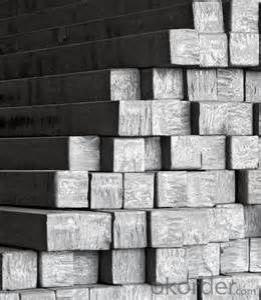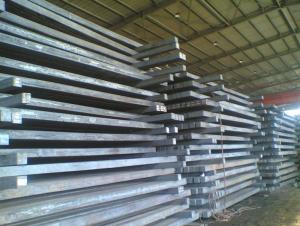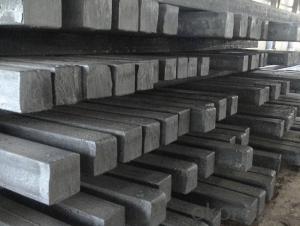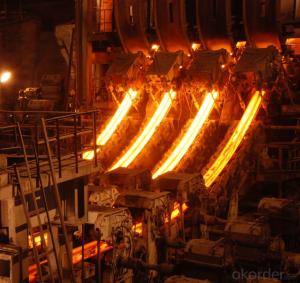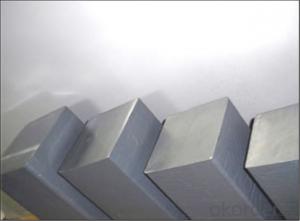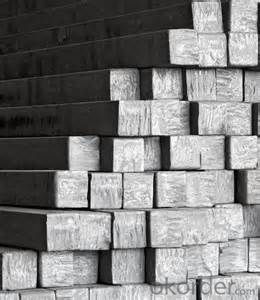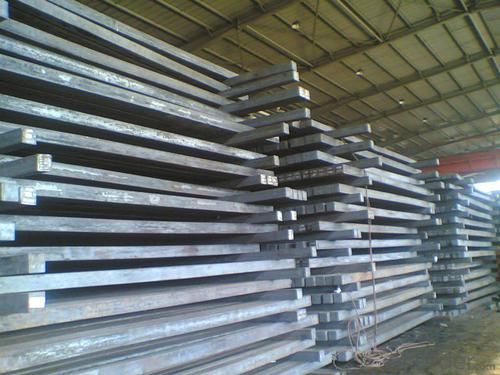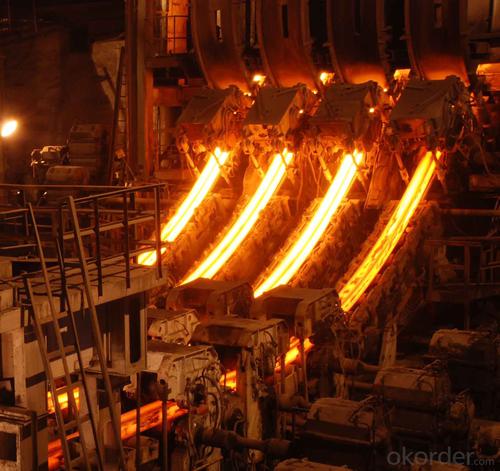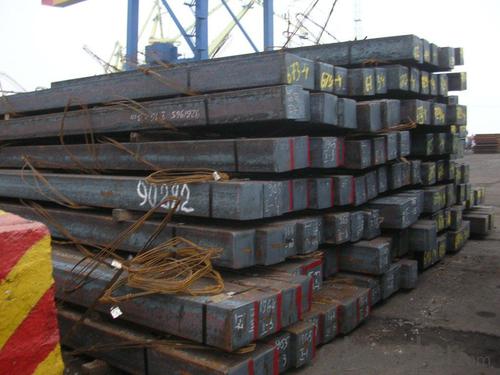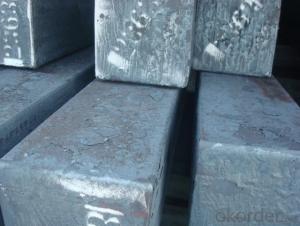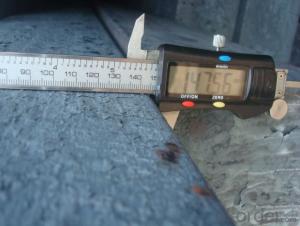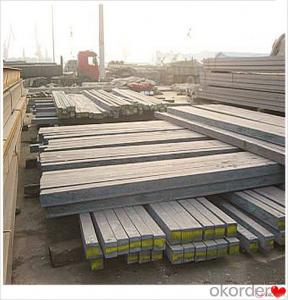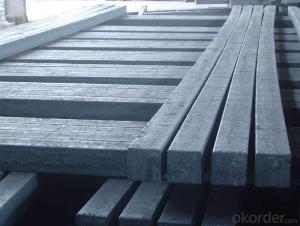Square Steel Billet Q235 3SP Grade Prime Quality 13#
- Loading Port:
- Tianjin
- Payment Terms:
- TT OR LC
- Min Order Qty:
- 2000 m.t
- Supply Capability:
- 50000 m.t/month
OKorder Service Pledge
OKorder Financial Service
You Might Also Like
Description of Square Steel Billet Q235 3SP Grade Prime Quality 13#
M. S. Billets are used for rolling of TMT Re-Bars of Fe415 and Fe500 Grade and various other structural steel products.
CRS Billets are used for rolling of CRS TMT Re-Bars.
Special Alloy Billets are used for rolling of any special grade TMT Re-Bars like Earthquake resistant TMT Re-Bars and for special grade structural steel products.
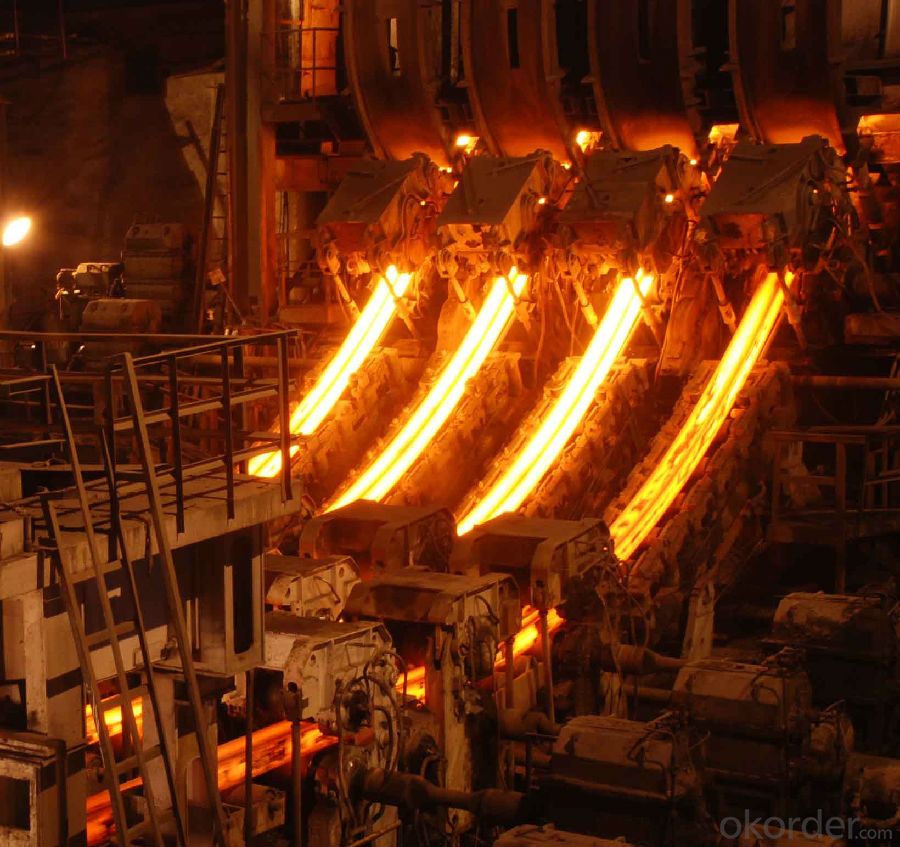
Main Feature Square Steel Billet Q235 3SP Grade Prime Quality 13#
Raw elements(C,Fe,Ni,Mn,Cr,Cu.)---Smelted ingots by AOD finery---hot rolled into black suface---pickling in acid liquid---cold drawn----polished by automatically machine--- cutting into pieces---checking quanlity
Applications of Square Steel Billet Q235 3SP Grade Prime Quality 13#
Widely Used in the areas such as Stainless Steel Fasteners, Chains, Kitchen and Sanitary wares, Furniture handles, Handrails, Electroplating and Electrolyzing pendants, Foods, Electron, Petroleum, Construction and Decoration, etc. Products have a high strength after cold-working. Electronic products parts, Medical appliance, Springs, Bus Inside and Outside packaging and building, Street Lamp Posts, etc. Decoration materials and Outdoor Publicity Billboard. Used for the products which have the Anti-Stress Corrosion requirement. Electron Products, Table-wares, Bolts, Nuts, Screen Meshes, Cumbustors and so on.
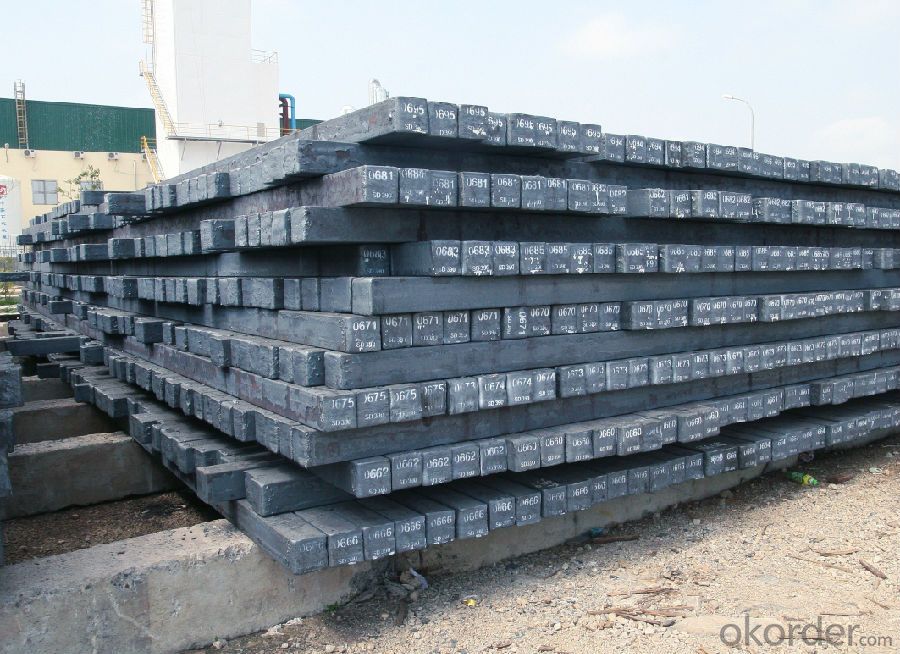
Specifications of Square Steel Billet Q235 3SP Grade Prime Quality 13#
| Standard | C(%) | Mn(%) | S(%) | P(%) | Si(%) |
| Q195 | ≤0.12 | ≤0.50 | ≤0.040 | ≤0.035 | ≤0.30 |
| Q235 | ≤0.20 | ≤1.40 | ≤0.045 | ≤0.045 | ≤0.35 |
| Q275 | ≤0.22 | ≤1.50 | ≤0.045 | ≤0.045 | ≤0.35 |
| 20MnSi | 0.17-0.25 | 1.2-1.6 | ≤ 0.050 | ≤ 0.050 | 0.40-0.80 |
| 3SP | 0.14-0.22 | 0.40-0.85 | ≤ 0.050 | ≤ 0.040 | 0.05-0.15 |
| 5SP | 0.28-0.37 | 0.50-1.00 | ≤ 0.050 | ≤ 0.040 | 0.15-0.30 |
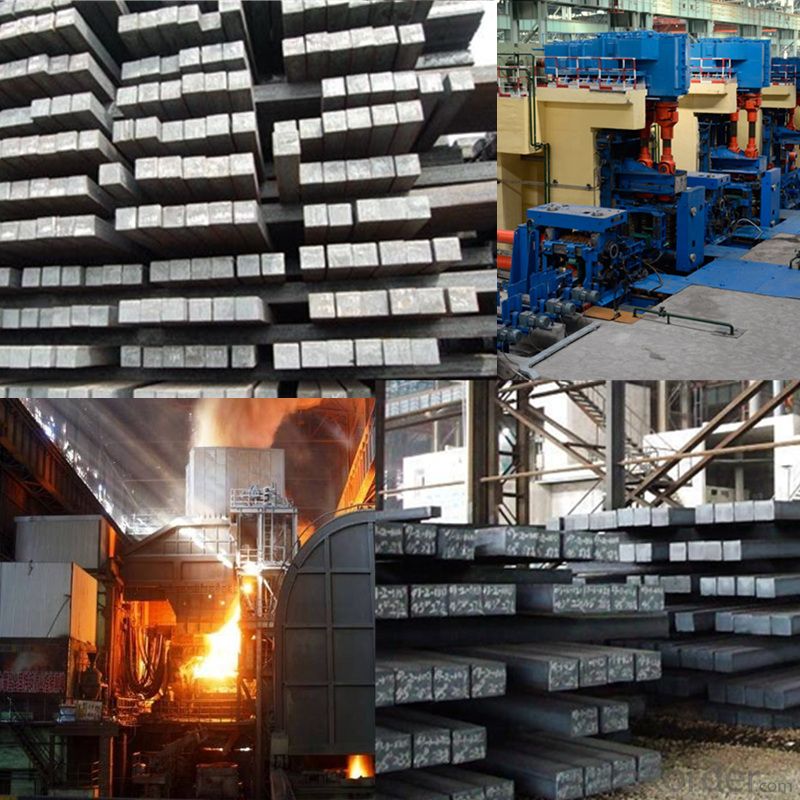
FAQ of Square Steel Billet Q235 3SP Grade Prime Quality 13#
We have organized several common questions for our clients,may help you sincerely:
1. How Can I Visit There?
Our company is located in Tianjin City, China, near Beijing. You can fly to Tianjin Airport Directly. All our clients, from home or aboard, are warmly welcome to visit us!
2. How Can I Get Some Sample?
We are honored to offer you sample.
3. Why choose CNBM?
Our delivery time about 15-20days for standard sizes, if you have other requirements like hardness, quanity and width ,it is about 20-40days. But don't worry we also try our best for the delivery time ,because time longer and our cost is higher.
- Q: What are the different types of steel billet handling equipment?
- There are several different types of steel billet handling equipment used in various stages of the steel production process. These equipment are designed to efficiently move and transport steel billets, which are semi-finished metal products used for further processing. 1. Overhead Cranes: Overhead cranes are commonly used in steel mills and foundries for the handling and transportation of steel billets. These cranes have a high lifting capacity and can move billets from one location to another within the facility. 2. Mobile Cranes: Mobile cranes are versatile and can be used for handling steel billets in both indoor and outdoor environments. They are equipped with hydraulic systems for lifting and maneuvering heavy loads. 3. Forklifts: Forklifts are commonly used in warehouses and storage facilities to handle steel billets. They have forks at the front that can be raised and lowered to lift and move the billets. 4. Grab Buckets: Grab buckets are used for handling bulk materials, including steel billets. They have a bucket-like structure that can be opened and closed to grab and release the billets. These are often used in ports and shipping yards for loading and unloading billets from ships. 5. Conveyor Systems: Conveyor systems are used for continuous movement of steel billets along a predefined path. They can be used to transport billets between different stages of the production process or to load and unload them from trucks or trains. 6. Roller Tables: Roller tables are used for transferring steel billets from one conveyor or machine to another. They typically consist of a series of rollers that allow for smooth and controlled movement of the billets. 7. Magnetic Lifters: Magnetic lifters use an electromagnetic field to lift and transport steel billets. They are particularly useful when handling ferrous materials, as the magnetic force allows for secure gripping and easy movement. 8. Palletizers: Palletizers are used to stack and organize steel billets on pallets. They can automatically arrange the billets in a specific pattern, making them suitable for storage or transportation. Each type of equipment has its own advantages and is used in specific applications based on the requirements of the steel production process. The selection of the appropriate handling equipment depends on factors such as the size and weight of the billets, the distance they need to be transported, and the specific needs of the facility.
- Q: Can steel billets be used for making architectural components?
- Yes, steel billets can be used for making architectural components. Steel billets are the raw material from which various steel products are formed, including architectural components such as beams, columns, and structural elements. The billets can be further processed through rolling, forging, or other techniques to create the desired shape and dimensions for architectural applications.
- Q: What are the common sizes of steel billets?
- Common sizes of steel billets vary depending on the specific application and industry. However, some commonly used sizes include 100mm x 100mm, 120mm x 120mm, and 150mm x 150mm. These sizes are often used in industries such as construction, automotive, and manufacturing.
- Q: What are the factors affecting the price of steel billets?
- There are several factors that can affect the price of steel billets. Some of the key factors include the demand and supply dynamics in the market, fluctuations in raw material prices (such as iron ore and coal), changes in energy costs, global economic conditions, geopolitical events, government policies and regulations, and technological advancements in the steel industry. Additionally, factors like currency exchange rates and transportation costs can also impact the price of steel billets.
- Q: What are the different types of non-destructive testing methods used for steel billets?
- Some of the different types of non-destructive testing methods used for steel billets include ultrasonic testing, magnetic particle testing, dye penetrant testing, eddy current testing, and visual inspection.
- Q: How are steel billets inspected for defects?
- Steel billets are inspected for defects through a series of thorough and systematic processes to ensure the quality and integrity of the final product. The inspection methods used may vary depending on the specific requirements and standards of the industry, but generally, the following techniques are commonly employed: 1. Visual Inspection: Skilled inspectors visually examine the surface of the billets for any visible defects such as cracks, surface irregularities, seams, or any other abnormalities. This is the initial step to identify any obvious defects that may affect the quality of the billets. 2. Magnetic Particle Testing (MPT): MPT is a non-destructive testing method that utilizes magnetic fields and iron particles to detect surface and near-surface defects in steel billets. The billets are magnetized, and iron particles are applied to the surface. If there are any defects, the magnetic field will cause the particles to cluster around them, making them visible to the inspector. 3. Ultrasonic Testing (UT): UT uses high-frequency sound waves to inspect the internal structure of steel billets. A probe is used to transmit ultrasonic waves into the billet, and the reflected waves are analyzed to determine the presence of any internal defects like voids, inclusions, or cracks. 4. Eddy Current Testing (ECT): This technique uses electromagnetic induction to identify surface and subsurface defects. A probe is used to create eddy currents within the billet, and any disruptions caused by defects will alter the electrical conductivity, which can be detected and analyzed. 5. Radiographic Testing (RT): RT involves the use of X-rays or gamma rays to inspect the internal structure of steel billets. The billets are exposed to radiation, and the resulting image is examined for any internal defects such as cracks, voids, or inclusions. 6. Ultrasonic Phased Array Testing (PAUT): PAUT utilizes multiple ultrasonic beams to inspect the entire volume of the billet. This technique allows for better defect detection and sizing by controlling the beam angle, frequency, and focus. These inspection methods are typically performed at various stages of the manufacturing process, including before and after the billets are heated, rolled, or further processed. By implementing these rigorous inspection techniques, manufacturers can identify and address any defects early on, ensuring the quality and reliability of the steel billets.
- Q: What are the main factors affecting the hardness of steel billets?
- The main factors affecting the hardness of steel billets are the carbon content, the alloying elements present in the steel, the cooling rate during the quenching process, and the heat treatment process employed.
- Q: What are the potential applications of steel billets in the food and beverage sector?
- Steel billets have a variety of potential applications in the food and beverage sector due to their strength, durability, and hygienic properties. These billets can be used to manufacture equipment such as food processing machinery, storage tanks, and transportation containers, ensuring safe and efficient handling of food and beverages. Additionally, steel billets can be utilized in the construction of commercial kitchen infrastructure, providing a strong and reliable foundation for food preparation areas.
- Q: How do steel billets contribute to the infrastructure development sector?
- Steel billets play a crucial role in the infrastructure development sector in several ways. Firstly, steel billets are the primary raw material used in the production of various construction materials such as rebars, beams, and columns. These materials are essential for the construction of buildings, bridges, roads, and other infrastructure projects. The use of steel billets ensures the strength, durability, and stability of these construction materials. Steel has exceptional tensile strength, which makes it ideal for withstanding heavy loads and adverse weather conditions. This, in turn, contributes to the safety and longevity of infrastructure projects. Moreover, steel billets are versatile and can be easily customized according to specific project requirements. They can be shaped into different forms and sizes, allowing engineers and architects to design structures with precision and efficiency. This flexibility enables the construction industry to create complex and innovative designs, enhancing the overall aesthetic appeal of infrastructure projects. Steel billets also contribute to the sustainability of the infrastructure development sector. Steel is a highly recyclable material, and the use of recycled steel reduces the demand for virgin materials and minimizes environmental impact. Additionally, steel structures can be dismantled and reused in other projects, promoting resource efficiency and reducing waste. Furthermore, the availability and affordability of steel billets make them an attractive choice for infrastructure development. Steel is widely produced and distributed, ensuring a steady supply for construction projects. The cost-effectiveness of steel billets allows for the construction of infrastructure projects within budget constraints, ensuring cost efficiency for both private and public investments. In conclusion, steel billets play a vital role in the infrastructure development sector by providing the necessary raw material for construction materials, ensuring strength and durability, allowing for customization and innovation, promoting sustainability, and offering cost-effectiveness. The use of steel billets contributes significantly to the growth and advancement of the infrastructure sector, enabling the construction of safe, resilient, and visually appealing structures that support economic development and improve the quality of life for communities.
- Q: How are steel billets used in the manufacturing of power transmission towers?
- Steel billets are an integral component in the manufacturing of power transmission towers. These towers, which are used to support electrical power lines, require a strong and durable material to withstand the weight and stress of the overhead cables. Steel billets, which are essentially semi-finished steel products, serve as the raw material for the fabrication of power transmission towers. The billets are typically made of high-quality steel, which possesses excellent strength and structural properties. The manufacturing process begins with the selection and preparation of steel billets. These billets are heated to a specific temperature, known as the forging temperature, in a furnace. Once the billets reach the desired temperature, they are transferred to a rolling mill, where they are shaped and formed into the required sections for the power transmission towers. Using various rolling techniques, the heated steel billets are transformed into long, slender sections known as angles, channels, or I-beams. These sections are carefully crafted to provide the necessary structural integrity and load-bearing capacity required for power transmission towers. Once the steel sections are formed, they undergo further processes such as cutting, drilling, and welding to create the tower's components. These components include the legs, braces, cross arms, and other reinforcements that make up the tower structure. The steel billets used in the manufacturing of power transmission towers are crucial for ensuring the towers' strength, stability, and longevity. Steel's high strength-to-weight ratio makes it an ideal material for supporting the weight of the cables and withstanding external forces such as wind and ice loads. Additionally, steel's resilience and durability make it capable of withstanding harsh environmental conditions, including extreme temperatures and corrosive elements. In conclusion, steel billets are a fundamental material used in the manufacturing of power transmission towers. Through a series of heating, rolling, and fabrication processes, these billets are transformed into the various structural sections and components that make up the towers. The use of steel ensures that the power transmission towers possess the necessary strength, stability, and resilience to support the electrical power lines effectively.
Send your message to us
Square Steel Billet Q235 3SP Grade Prime Quality 13#
- Loading Port:
- Tianjin
- Payment Terms:
- TT OR LC
- Min Order Qty:
- 2000 m.t
- Supply Capability:
- 50000 m.t/month
OKorder Service Pledge
OKorder Financial Service
Similar products
Hot products
Hot Searches
Related keywords
